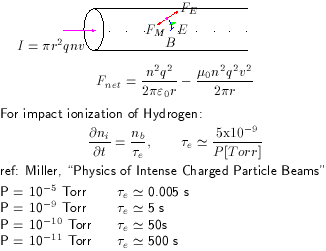
Space charge neutralization occurs when impact ionization of residual gas leaves positive ions that are drawn into the beam, destroying the delicate balance between self focusing and radial space charge force.

Ultra-high vacuum is, therefore, critical. Mitigating factors are that the ions are naturally pumped by the accelerator tube fields and recombination takes place at some rate. If these are insufficient, crossed field ion clearing electrodes could be installed.
Advanced vacuum techniques will be applied including:
Beam halo, in this case, would likely result from cathode edge emission. If this occurs, it may be possible to reduce the gap between cathode and focusing electrode or poison emission from the side of the cathode.
High charge collection efficiency is guaranteed by use of a multi-stage depressed collector. The collector does have finite acceptance (in this case <50 KV) which must not be exceeded.
Ionization of the SF6 insulating gas might result from X-rays generated by beam loss in the decelerator tube. This could destabilize the tube's field gradient resulting in arcing. This could impose even more stringent loss limitations than planned and will warrant careful study.